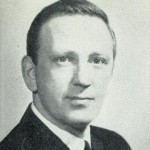Reading Time: 9 minutes
In 1852, as the northern Indiana manufacturing town of South Bend steadily grew, brothers Henry and Clement Studebaker founded a small business that manufactured metal parts for freight wagons. As the California Gold Rush enticed more Americans to head west, it wasn’t long before they were operating a profitable business building entire wagons themselves. Quickly gaining a reputation for the quality of their product, they soon received orders from the U.S. Army, and in 1857 began building horse-drawn carriages, as well. The Civil War brought on boom years for the upstart company, and in the immediate years that followed South Bend incorporated as a city and the business incorporated as Studebaker Brothers Manufacturing Company.
As the intercontinental railroad system was finished and roads became paved, the company continued to rapidly grow. By 1875, they had built the largest vehicle manufacturing facility in the world where they produced over a half-dozen styles of carriages and wagons on over 100 acres of property. In 1902, they started producing horseless, electric automobiles, and in 1912 produced some of the first gasoline-powered cars. Fueled by military orders in World War I, they were on the cutting edge of automobile innovation and continued to thrive, and the city thrived along with them. By the 1930’s, their manufacturing footprint had grown to 7.5 million square feet of floor space spread over 225 acres. They produced 180,000 cars each year and employed 23,000 people–nearly one out of every six people living in the South Bend metropolitan area.
Though Studebaker was an early leader in engineering innovation, by mid-century they lagged far behind Ford and General Motors when it came to innovation in the manufacturing process. As a result, Studebaker’s cars were produced less efficiently, and thus cost more. Sales fell, they ceased operations in South Bend at the end of 1963, and were out of business altogether less than three years later. The support industry began to crumble, and the city’s population began a decades-long decline. But if the history of the first hundred years of South Bend is largely tied to the legacy of Studebaker, the history of the city’s last half-century is largely tied to the legacy of the young Congressman who helped the city recover.
//
Stephen John Brademas was born at the height of the Studebaker Era in South Bend’s twin city Mishawaka on March 2, 1927. His father was a Greek immigrant who ran a restaurant, and his mother was a school teacher. As so often happens with the children of immigrants, and also with middle class kids in blue collar cities, young John’s parents impressed on him often the value of education. Thus began a lifelong love of learning. That love was continually fostered when he would spend his summers with his mother’s father, a school superintendent and college professor with a large library.
The early impressions paid off: Brademas would eventually graduate as the valedictorian of Central High School in South Bend, and then–after a two year stint in the Navy that saw him stationed in Milwaukee–graduate magna cum laude from Harvard with a major in government. From Harvard he attended Oxford University as a Rhodes Scholar, earning his doctorate in social studies. At first, Brademas wasn’t sure what he wanted to do with his life. As he once recalled, “After an initial flirtation with the idea of going into business, into export-import work in Latin America, which is something I thought I wanted to do when I was in the 9th grade, I decided I would go into either the United Nations or the Foreign Service or run for Congress.” It didn’t take him long to decide.
The third time’s a charm
[pollink pid=”552″], was the two-term Republican Congressman for Indiana’s 3rd Congressional District. The district favored Republicans, and the Crumpacker name had some gravitas: His cousin, [pollink pid=”960″], had previously served eight terms representing Indiana in the U.S. House. He [elexlink year=”1950″ office=”6″ type=”1″]won his first election[/elexlink] by a handy 6.41% margin, and then [elexlink year=”1952″ office=”6″ type=”1″]cruised to reelection[/elexlink] by 9.61% in 1952. Unfazed, a 27-year-old Brademas launched a campaign to unseat him. Though unsuccessful, he [elexlink year=”1954″ office=”6″ type=”1″]came surprisingly close[/elexlink] and lost by a razor thin 50.37%-49.18% tally.
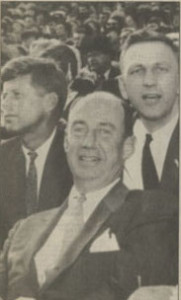
The campaign caught the attention of Adlai Stevenson, who hired Brademas to work on his 1956 presidential campaign against President Dwight Eisenhower. But it also caught the attention of Crumpacker, who decided to retire at the end of his third term rather than face a rematch with Brademas. Though the open seat should have played into Brademas’ favor, it was still a Republican district in a year that saw a popular Republican President on the top of the ticket. [pollink pid=”516″] easily [elexlink year=”1956″ office=”6″ type=”1″]defeated him by more than six points[/elexlink]. But midterm elections are rarely good for second term presidents, and 1958 was particularly bad for Republicans. Among the 48 seats they lost in the House that year was Nimtz’s, who saw his [elexlink year=”1958″ office=”6″ type=”1″]six-point win turn into a seven-point loss on Brademas’ third try[/elexlink].
Saving South Bend
At just 31 years old, John Brademas was sworn in as a U.S. Representative, the first Greek-American to serve in either branch of Congress. During the Stevenson campaign two years prior, he had begun to form a strong network of connections with “the shakers, movers and intellectuals” of national politics that would be vital to his time in Washington. From the outset, he was able to parlay his belief in a strong education into a seat on the House Committee on Education and Labor. But while his primary motivation had been to influence education policy, the committee’s jurisdiction over labor issues would initially prove to be more important to his political career.
By the early 1960’s, it was clear that Studebaker was on shaky financial footing. A series of last-ditch efforts and corporate changes in the 1950’s intended to jump start sales had largely failed. With bankruptcy looming, Brademas and Senator [pollink pid=”143″] went to the White House in August 1963 to lobby President John F. Kennedy for federal support to prop up the failing corporation. Despite the friendship Brademas and Kennedy had forged during Stevenson’s campaign, the president said there was nothing he could do to help.
In the weeks following Kennedy’s assassination later that year, Studebaker announced it was immediately closing it’s South Bend manufacturing plant; within a few years, the entire company would fold. Brademas was tireless in his efforts to help his constituents who were suddenly out of work. He took Bayh and Senator [pollink pid=”144″] to the White House to secure support from President Lyndon Johnson for worker retraining programs, and then a few months later brought Johnson to South Bend to see them firsthand. When thousands of former employees found themselves without the pensions they had been promised, he argued vehemently for pension reform, and the Studebaker story he told helped bring about the Employee Retirement Income Security Act (ERISA) in 1974. Still largely in effect today, ERISA established the Pension Benefit Guaranty Corporation (PBGC) to insure underfunded pension plans and protect tens of millions of workers nationally.
Perhaps most importantly, however, Brademas used his vast network of connections to quickly bring in $80 million worth of government contracts to build military and postal vehicles. Kaiser Jeep bought the General Products Division of Studebaker and assumed the contracts, and within a few years were able to reemploy a good number of former Studebaker workers. Today the company is known as AM General, and they still produce military Humvees and civilian Hummers from South Bend and Mishawaka.
While other rust belt cities have similar stories of rapid decline due to the loss of a large manufacturer, South Bend was able to avoid the complete decimation seen elsewhere largely because of Brademas. It made him an instant hero with his constituents and paid huge dividends electorally: Before the Studebaker crisis he won his first two reelection contests by [elexlink year=”1960″ office=”6″ type=”1″]4.84%[/elexlink] and [elexlink year=”1960″ office=”6″ type=”1″]3.80%[/elexlink], respectively. In its aftermath, he won his Republican-leaning district in 1964 by [elexlink year=”1964″ office=”6″ type=”1″]21.30%[/elexlink], and only once thereafter won with less than 11%.
Education’s White Knight
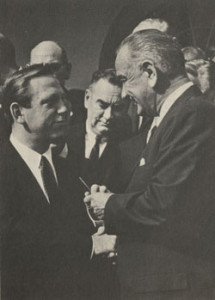
While Brademas’ importance to Indiana comes primarily from his Studebaker work, his importance to the nation comes primarily from his work on his first love, education policy. In the 1960’s and 1970’s, he was involved in every major piece of legislation dealing with elementary and secondary education; higher education; vocational education; services for the elderly and handicapped; and federal support for libraries, museums and the arts and humanities.
In 1965, he helped write the bill that created the National Endowment for the Arts (NEA) and the National Endowment for the Humanities (NEH). That same year he was deeply involved with writing the first Elementary and Secondary Education Act (ESEA), a major component of President Johnson’s “War on Poverty” that still governs federal education policy today. In 1969, he was named chairman of the Select Subcommittee on Education, giving him oversight powers of the entities those bills established, as well as a prime perch to write new policy. Among the many laws he authored were the Arts, Humanities and Cultural Affairs Act; the Arts and Artifacts Indemnity Act; the Museum Services Act; the Library Services and Construction Act; the National Commission on Libraries and Information Services Act; the Education for All Handicapped Children Act; the Alcohol and Drug Abuse Education Act; and the International Education Act. He was also instrumental in writing the Higher Education Acts of 1972 and 1976, which established guidelines for federal financial aid for students, as well as the legislation that created the National Institute of Education.
Because of his work in this space, as well as authoring the Older Americans Act that still today provides services to help the elderly and infirm live independent lives, he garnered many nicknames in the press: Education’s White Knight, Mr. Arts, Mr. Education, and Supercongressman, among others.
Speaker-in-Waiting
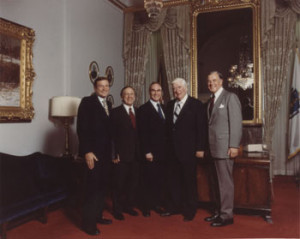
Brademas’ effectiveness as a legislator won him many fans. Perhaps none was as important as Tip O’Neill. As O’Neill worked through the ranks of party leadership from Whip in 1971 to Majority Leader in 1973, he came to view Brademas as an important protege. When House Speaker Carl Albert got caught up in an international bribery scandal in 1976 and announced he would retire at the end of his term, O’Neill quickly set to work locking up his votes. Brademas was part of the inner circle working the caucus for votes; O’Neill made it clear that if he won, Brademas would be part of the leadership team. When O’Neill ultimately prevailed, he kept his word and made Brademas the Majority Whip.
As soon as he assumed the post in 1977, speculation began that O’Neill was grooming Brademas as the next Speaker of the House. It was clear O’Neill held him in high regard, and every Speaker since Sam Rayburn had died had first served as Whip. In addition, despite having served in the House for 18 years, he was still relatively young at just 49 years of age and had plenty of time to wait for the Speakership to open up. But it was never to be.
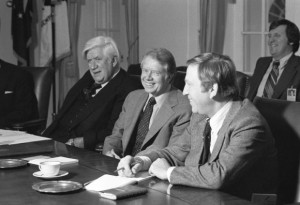
Four years later, Brademas–like so many other Democrats in 1980–was drowned in the midst of the Reagan wave. [pollink pid=”346″], like Brademas before him, was just 27 years old when he decided to challenge an incumbent member of the House. Unlike Brademas, however, Hiler only needed one shot to win, pulling off an astounding [elexlink year=”1980″ office=”6″ type=”1″]54.98%-45.02% landslide victory[/elexlink]. It was the most shocking political upset in decades, and wouldn’t be rivaled until House Speaker Tom Foley would lose in 1994.
Life After Congress
Brademas wasted no time in rebounding from this defeat. In 1981, he was hired as the President of New York University, continuing his quest to strengthen the American education system. Over the next decade, he would transition the school from a regional commuter school into an internationally renowned residential research university. He worked tirelessly to integrate himself into various New York City social scenes: While serving as NYU’s president, he also landed spots on the boards of the New York Stock Exchange, the Rockefeller Foundation, the RCA Corporation, the Loews Corporation, and Scholastic Publishers, among others; was made Chairman of the Board for the New York Federal Reserve; and headed up various commissions for the New York state government and the federal government.

When he resigned his post in 1992, he was made President Emeritus of the university. Once asked why he was so relentless about growing NYU and keeping a grueling schedule of board meetings at the same time, Brademas referred back to his role in the Studebaker crisis decades before: In the 1960’s, he had helped assemble a coalition of government, business, and labor leaders to help protect the workers and save South Bend. What he felt was missing was input from local universities and colleges, who could have been vital in education and training programs for displaced workers. His reasoning in New York was simple: “I want to help forge those connections.”
//
Like his hometown in the 1960’s, John Brademas refused to let a monumental defeat serve as anything more than a speed bump on his path forward. For other politicians the 1980 election could have served as a sad ending to a storied career, just as Studebaker’s closing could have meant the something similar for South Bend. But in both cases, Brademas refused to yield, and through tireless effort was able to recognize brand new opportunities.

